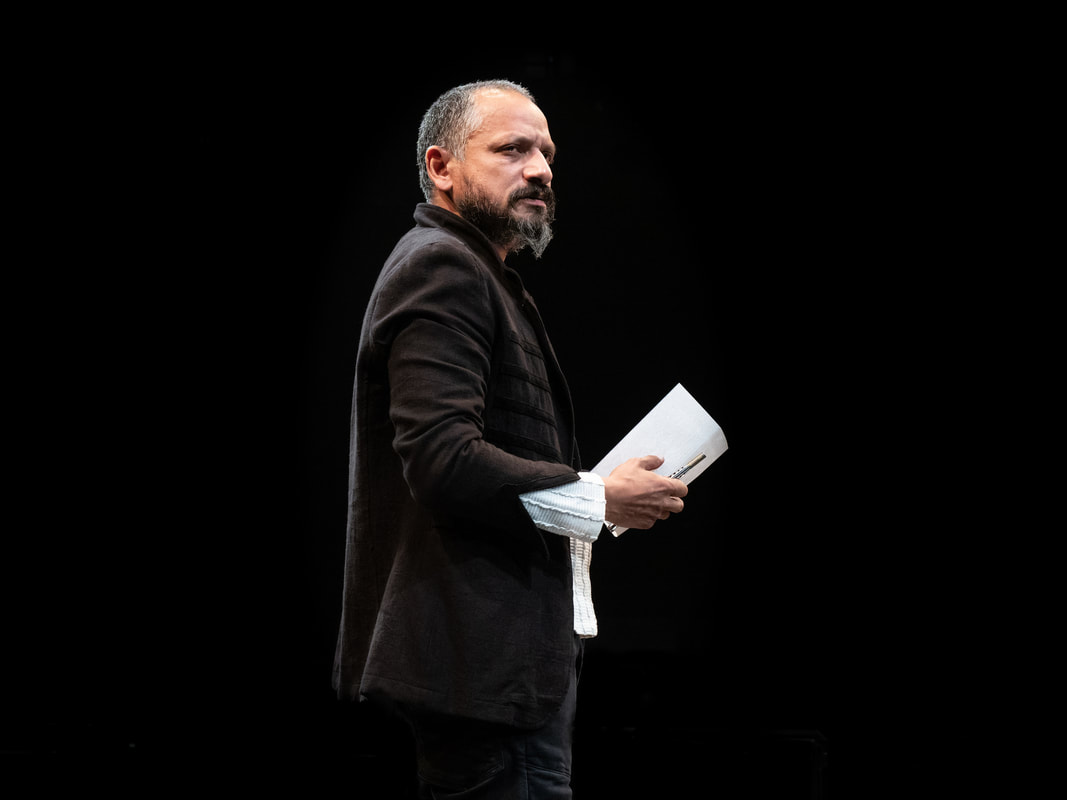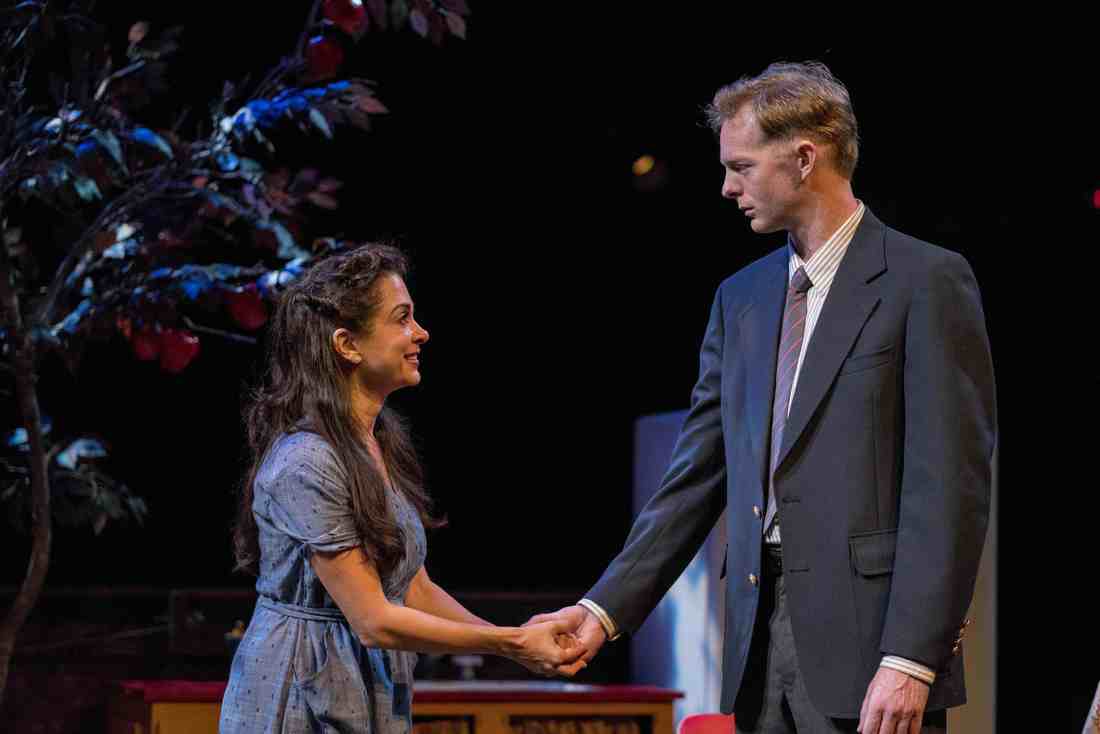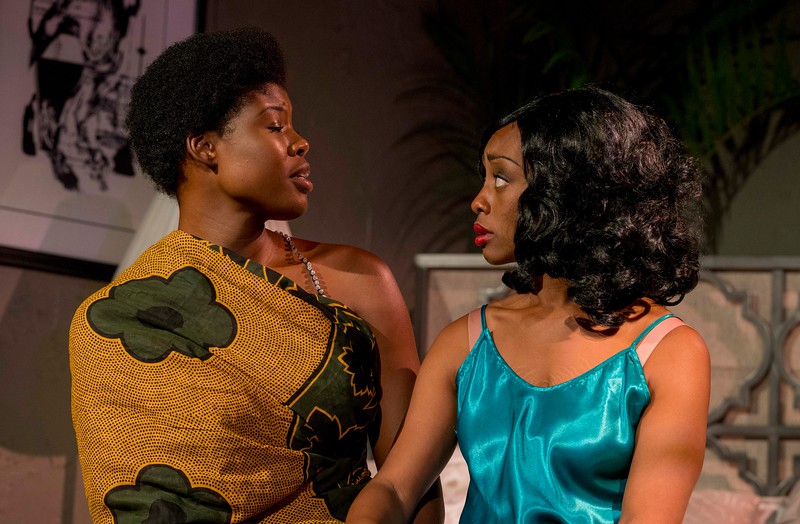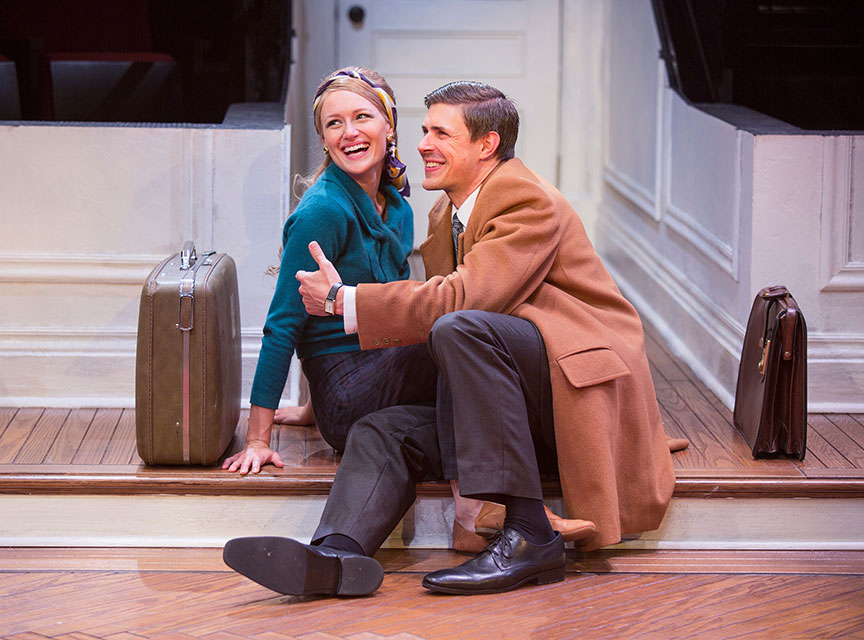|
Jesse J. Perez in "Seize the King." Photo courtesy of La Jolla Playhouse At one point in Seize the King, playwright Will Power’s reimagination of Shakespeare’s Richard III, Richard makes a pointed distinction between “not the truth” and a “lie.” He also rails against immigrants and insists on the loyalty of those in his sphere. If that characterization bears resemblance to someone currently occupying a position of great power, it’s purely intentional. But Power’s new play, making its world premiere at La Jolla Playhouse, also honors The Bard’s 16th-century treatise on the struggle between goodness and evil in an adaptation of Richard III that is bold, exciting and propulsive.
Power, who is a pioneer of hip-hop theater, has turned Shakespeare’s second-lengthiest work (after Hamlet) into an urgent, 95-minute play that ingeniously mixes the formal language of Richard III and a contemporary, streetwise vernacular replete with fast-flying metaphors and profanities. The end result is a sharp, lyrical script that blurs the line between the past and the present, while positing that ambition and depravity are not the province of merely one king, one country or one moment in time. Seize the King marks the last Playhouse directing stint for Jaime Castaneda, its outgoing associate artistic director, who’s headed to L.A. It’s a grand finale for him, with a tight five-person cast fronted by Jesse J. Perez. His Richard is not the odious, deformed king of classical interpretations, but a conniving, devious figure who levelly addresses the audience, and whose basest passions simmer beneath the surface. Power’s play omits a great deal of Shakespeare’s text and interweavings, and many of Richard III’s characters (all but Perez play multiple parts in Seize the King). This is a Richard III for the 21st century served up with more humor, but with the same cautionary themes and no less ferocity. Much of that ferocity comes from drummer Richard Sellers, whose percussion from above the stage provides transitions between Seize the King’s short scenes and fills the Playhouse’s Potiker Theatre with pulsating dramatic tension. The theater-in-the-round setting, enhanced by the magic of lighting designer Tyler Micoleau, further ensures that Seize the King is a stirring, immersive show, and one that should not be missed. (Review originally published in San Diego CityBeat on 8/29/18.)
0 Comments
Jessica John and Brian Mackey in "Smokefall." Photo by Daren Scott The worlds of playwright Noah Haidle’s “Smokefall” are disparate and inscrutable. Act I (titled “Help Me Remember”) unfolds in a Grand Rapids, Mich., that smacks of David Lynch’s fictitious Twin Peaks, Wash. It’s a baleful place where an old man’s fading memory is only one of multiple family disturbances. Act II (“Where We’ll Never Grow Up”) is set in inside the womb of pregnant wife Violet. The unborn twins residing there could best be described as metaphysical vaudevillians. Then there’s Act III (“The Attempt Is How We Live”), occurring more than 70 years in the future, yet somewhere in which the past and the present converge.
In short, 3-year-old Backyard Renaissance could not have picked a more ambitious work to launch its tenure as La Jolla Playhouse’s resident theater company. “Smokefall,” which premiered five years ago at South Coast Repertory Theatre in Costa Mesa, is as challenging a play for audiences as it undoubtedly must be for the Backyard Renaissance cast (Jessica John, Brian Mackey, Francis Gercke, Antonio TJ Johnson and Fedra Ramirez Olivares) directed by Gercke and Andrew Oswald. But in spite of this complex yet literate play’s mind games, it does make for absorbing theater. In the Grand Rapids household, the expectant Violet (Jessica John) goes about her familial duties with resolute smiles, though an aura of sadness envelops her. Husband Daniel (Gercke) is haunted by “malaise and dread,” which foretells his pending departure. Traumatized daughter Beauty (Ramirez Olivares) does not speak, and she subsists on non-nutritious “food” including dirt and paint. The Colonel (Johnson), Violet’s father, is drifting toward dementia. All this is imparted less by the characters themselves than by the onstage presence of a narrator (Mackey), whose spoken “footnotes” provide back story and context. It’s an intrusive device that is the play’s one tangible weakness, though the narrator’s words do demonstrate Haidle’s eloquence and insight into love, loss and the perpetual mystery of time. The ominous tone of the first act is soon washed over by the in-womb antics of Act II. Mackey and Gercke as the unborn twin brothers, each clad in argyle sweaters and matching socks, and attached to neon-glowing umbilical cords, banter like bratty but extraordinarily cerebral kids. Theirs is a nearly slapstick, noogy-filled battle of philosophical existentialism. This debate will have shocking consequences before the third act, when in a less fantastical but equally exigent milieu, the question of whether the course of a life is genetically predetermined is confronted. As the Colonel and later as the aged incarnation of one of the twins, Johnson has the meatiest part in the production, and duly brings the passion and poignancy. John “speaks” expressively with her eyes and benumbed smiles, subtly conveying Violet’s struggle against melancholy. Gercke and Mackey come most alive when wildly in utero together, while Ramirez Olivares melds tender and haunted as the story’s seeker, Beauty. Incongruous and even preachy as it can be at times, “Smokefall” is a risky and venturesome play produced by a company that espouses “gutsy intensity” in its mission statement. Mission accomplished. (Review originally published in the San Diego Union-Tribune on 8/27/18.) No work of Shakespeare’s has been staged at the Old Globe as many times as Much Ado About Nothing – 13 as a matter of fact in the Balboa Park theater’s 83-year history. This should come as no surprise. Either Much Ado or Twelfth Night must be regarded as The Bard’s most entertaining comedy.
The Globe’s latest production of Much Ado About Nothing, the capper of the 2018 Summer Shakespeare Festival, is a total audience pleaser from start to curtain. Directed by Kathleen Marshall, who oversaw a well-received Love’s Labor’s Lost at the festival two years ago, this Much Ado starts with an exceptional Beatrice and Benedick, the sniping, reluctant lovers at the heart of the story. Both Sarah Topham and Michael Hayden demonstrate a gift for physical humor as well as snappy repartee, with much of their laughs earned by scampering about the lush Italian estate set in order to remain unseen by those characters gossiping for their benefit. While the play’s other pair of lovers, Claudio (Carlos Angel-Barajas) and Hero (Morgan Taylor) are attractive/nothing more, the supporting cast includes a stentorian-voiced Leonato in Rene Thornton Jr., a hapless constable Dogberry in Fred Applegate and two gypsy musicians (guitarist James Michael McHale and violinist Abigail Grace Allwein) who provide atmospheric music compatible with the production’s 1930s, Italian Riviera setting. So inviting is John Lee Beatty’s scenic design – a sunny two-story villa accented in turquoise, with a view inside downstairs of an elegant dining room, and airy balconies above overlooking a courtyard of bubbling fountains – that theatergoers will long to be guests at the play’s masked party or weddings – yes, there’s more than one ceremony here. In Michael Krass’ costumes, everyone who’s supposed to looks divine for the 1930s, and Stephen Strawbridge’s lighting sets the right mood for all of Much Ado’s dalliances, deceptions and flirtations. If the musicality of this production falls in love with itself by show’s end, this can be forgiven. All misunderstandings are resolved by that time, and unabashed giddiness is in the night air. (Review originally published in San Diego CityBeat on 8/22/18.) Joy Yvonne Jones (left) and Cashae Monya in "Voyeurs de Venus." Photo courtesy of Moxie Theatre The story of Saartjie Baartman is horrific. A Khoikhoi woman who lived in southwestern Africa around the turn of the 19th century, she would leave her native country upon a British trafficker’s promise of making money for a better life, only to become a victim of exploitation, degradation and all manners of abuse. She would be turned into a sideshow humiliation: the “Hottentot Venus.” Baartman’s body, in particular her backside, were sexualized for the titillation and gawking of white Europeans. Even after her premature death, Baartman’s body would be victimized, turned into another kind of exhibition that demeaned her physicality and her soul.
Fittingly, Lydia R. Diamond’s 2006 “Voyeurs de Venus,” which launches Moxie Theatre’s 14th season, opens with a nightmare: not one to torment Baartman, who must have endured many, but young Sara Washington, who awakens terrified. For the 21st-century cultural anthropologist (Cashae Monya), this is a premonition, dramatized onstage like all of her bad dreams to come in a feverish dance sequence choreographed by Michael Mizerany. “Voyeurs de Venus” reunites three principals from Moxie’s powerful production of “The Bluest Eye” five years ago. Diamond wrote the stage adaptation of Toni Morrison’s 1970 novel; Moxie co-founder Delicia Turner Sonnenberg directed; and Monya fronted a stellar cast. With “Voyeurs de Venus,” Turner Sonnenberg, Moxie’s former artistic director, has conceived an uncompromising, visceral theater experience that is very much in keeping with the pain and tumult that inhabited Baartman’s tragic life. Diamond’s lengthy play flits back and forth in time, telling Baartman’s story in the early 1800s and that of Sara, an exuberant, scrupulous academic who is offered a lucrative book deal to tell the “Venus Hottentot” story in an “entertaining” fashion. Her anguish and (though she’s loath to admit it) guilt over the possibility of exploiting Baartman are exacerbated to dramatic effect by the spirit of the Khoikhoi woman (Joy Yvonne Jones) sometimes literally over her shoulder, by the recurring dance nightmares (most, but not all, essential to the narrative), and by an affair with her publisher (Cortez L. Johnson). When Sara isn’t navigating these internal and interpersonal riptides, she’s speaking directly to the audience (once, with the house lights up), providing a window into this conflicted character’s intelligence and conscience. Monya renders a fearless, charismatic performance, with Jones a mesmerizing presence as Baartman. The 1800s flashback scenes are stagier. Fred Harlow has the one-note role of the trafficker Dunlop, while Justin Lang, who in the contemporary scenes plays Sara’s supportive husband, holds nothing back as the odious Georges Cuvier, the “founding father of paleontology” who would later reduce Baartman’s remains to a “scientific” freak show. As commentary, “Voyeurs de Venus” aspires to indictments on race, objectification, identity, cultural appropriation and even gentrification -- a daunting order, to be sure, for one play. As stark drama told with urgency, “Voyeurs de Venus” is a reminder of man’s inhumanity to woman, and indeed to all who are devalued and disrespected for nothing more than being human. (Review originally published in the San Diego Union-Tribune on 8/20/18.) Hairspray may be environmentally problematic, but when it comes to social responsibility, Hairspray the Broadway musical has been delivering an important message for more than 15 years: that inclusion should be a matter of course and diversity should be embraced. Filmmaker John Waters was trying to make these points 30 years ago when his “Hairspray” movie was released and became a cult favorite if not a commercial success. With the arrival of the musical adaptation in 2002, which Waters signed off on, the messaging was wrapped in an audience-pleasing score by Mark Shaiman with lyrics by Shaiman and Scott Wittmann bursting with teen rebellion, sexual innuendo and pop-cultural nods to the story’s setting in 1962 Baltimore.
The winning formula of song, dance, comedy and conscience persists in San Diego Musical Theatre’s production of Hairspray, directed by J. Scott Lapp. In spite of the Horton Grand Theatre’s uneven acoustics and a stage cramped for dance numbers of this show’s size, SDMT’s cast mines all this show’s empathic and joyful moments. It starts, as productions of Hairspray, always do, with an uproarious Edna Turnblad, a woman of great girth always played by a man. SDMT’s Edna is John Massey, who doesn’t disappoint. “She” has a veteran of local musical theater, Steve Gunderson, playing Edna’s joke-shop-owning hubby Wilbur. Bethany Slomka makes an, ahem, big impression as daughter Tracy, who in longing to perform on a teenage dance show on TV, takes up the cause of racial discrimination. This Hairspray is populated by a slew of dependable musical-theater performers including Eileen Bowman as Velma Von Tussle, Zackary Scot Wolfe as TV host Corny Collins, and Debra Wanger, who makes the most of a small part. The ensemble as a whole is diverse and athletic during Hairspray’s dance numbers, choreographed by Jill Gorrie. While Hairspray’s commentary remains unfortunately relevant, its early-‘60s name-dropping will escape younger theatergoers, those for whom Eddie Fisher, Perry Como and the Gabor sisters are head-scratchers. But patrons of all ages should appreciate the notions of love and acceptance of who we and others are. Unlike bows and plaid skirts, those never go out of style. (Review originally published in San Diego CityBeat on 8/15/18.) Kerry Bishe and Chris Lowell in "Barefoot in the Park." Photo by Jim Cox Were newlyweds ever as cute as they are in Neil Simon’s Barefoot in the Park? Beginning a new life together in an impossibly impractical apartment in New York and subsisting on hugs and kisses is pretty much the entire premise of Simon’s 1963 comedy. By the standards of today, when relationships, much less marriage, are as complicated as Pythagorean identities, Barefoot in the Park feels sugar-sweet, even naïve. The trick is to forget about reality and just enjoy the sweetness and naivete. The Old Globe’s new production of Barefoot in the Park makes it easy.
Start with a uniformly talented cast. Kerry Bishe conveys all of the over-the-top giddiness about life and love inside Corie Bratter, the new bride who believes everything is so wonderful that even sleeping in a closet turned “bedroom” is no inconvenience. Better still is Chris Lowell as her understandably beleaguered (and a little overwhelmed) new husband, Paul. As disarming as Bishe and Lowell are in the first act of the play, when the conflict is mostly about the haplessness of the tiny brownstone apartment, they’re twice as much fun in the argument scenes later. There’s never any doubt that the Bratters will work things out, but until they do their back-and-forth barbs can be enjoyed guilt-free. Simon’s wittiest writing is heard in Corie’s and Paul’s quips and benign sarcasm. The playwright conceived meaty supporting roles for this snappy comedy. As Corie’s timid but lovable mother, Mia Dillon gently plays off the exuberance of Bishe as well as that of Jere Burns as neighbor Victor Velasco, “the Bluebeard of 48th Street.” His is the most broadly drawn character in the play, but he mostly reigns in what could have been a cartoon part. Director Jessica Stone was intuitive enough to craft a Barefoot in the Park that skips along, never trying to be weighty or relevant. Her ensemble’s comic timing is tight, and the otherwise breezy rhythm of the show is hindered only by the apparent necessity of two intermissions. The retro music sprinkled into the action and the animated unveiling of the Bratters’ furniture when it first appears add to the enchantment of the goings-on. If only love were as magically achieved. (Review originally published in San Diego CityBeat on 8/8/18.) Implausible and predictable as it was, the 2001 film “Legally Blonde” succeeded primarily because of the on-screen charms of Reese Witherspoon. While the 2007 stage musical adaptation that premiered in 2007 was Reese-less, it too succeeded, relying on a dependable formula of cleverness and corn.
Legally Blonde The Musical is based both on the movie and (like the film) a novel by Amanda Brown. Brown’s experiences at Stanford Law School were the inspiration for those of the Malibu Barbie named Elle Woods, who after being dumped by her Harvard Law School-bound boyfriend Warner, finagles her way into Harvard herself. There the antics ensue and the maturation of seemingly vacuous Elle takes place. New Village Arts in Carlsbad has opened its new season with Legally Blonde The Musical (book by Heather Hatch; music and lyrics by Laurence O’Keefe and Nell Benjamin). NVA’s is a true ensemble effort, with no one member of the cast (even Danielle Levas as Elle) owning the production. That includes the potentially scene-stealing dog Monty (aka Rufus), one of two canines with stage time. The merit of Legally Blonde The Musical is its often laugh-out-loud lyrics which spoof the shallowness of wealth, contemporary relationships and the stuffiness of bastions of protocol and self-importance like Harvard. The beautician subplot from the film is carried over, with Marlene Montes memorable as the wisecracking but issued Paulette. The recurring presence of Elle’s “muses” chorus (specters of her sorority sisters) adds sauciness and choreography to the proceedings. While the first act of Legally Blonde The Musical is, despite its length, tightly woven, the show goes rather off the rails in Act 2, with the gyrating “Bend and Snap” in particular interrupting rather than moving along the story. The case Elle is trying, too, wraps up so conveniently it raises the question of what all the pretrial fuss was about. This is quibbling. Legally Blonde The Musical is, like its screen predecessor, eye and ear candy ideally suited to a girls night out or a first date. When a show comes with funny lines, beautiful clothes (designed by Samantha Vesco), a fine band (directed by Tony Houck) and a couple of dogs, what’s to complain about? (Review originally published in San Diego CityBeat on 8/1/18.) |
AuthorDavid L. Coddon is a Southern California theater critic. Archives
July 2024
Categories |
David Coddon |
|



